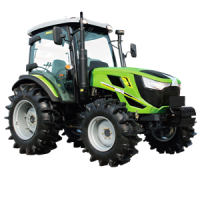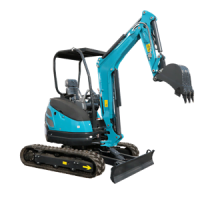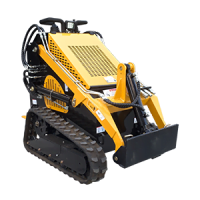Exploring Excavator Bucket Types: A Comprehensive Guide.When it comes to excavating, the excavator bucket is an essential component that greatly influences the efficiency and effectiveness of the task. Excavator buckets come in various types, each designed for specific applications. In this article, we will delve into the world of excavator buckets, discussing their types, importance, factors to consider when choosing the right one, and the benefits of specialized buckets.
Introduction
Excavator buckets play a crucial role in the world of construction and excavation. These heavy-duty attachments are the backbone of any excavation project, facilitating tasks such as digging, scooping, and material handling. The choice of the right excavator bucket type can significantly impact the efficiency, productivity, and overall success of a project. In this comprehensive guide, we will explore the diverse world of excavator buckets, discussing their various types, their importance in construction and excavation, and the key factors to consider when selecting the perfect bucket for your specific needs. Whether you’re a construction professional or simply curious about heavy machinery, this article will provide valuable insights into the world of excavator buckets.
Importance of Choosing the Right Excavator Bucket

Selecting the appropriate excavator bucket is of paramount importance in the construction and excavation industry. It directly impacts the efficiency and effectiveness of an excavator’s performance on a job site. The excavator bucket, the workhorse of any digging and material handling operation, is not just a one-size-fits-all tool. Choosing the right type of bucket is critical for several compelling reasons.
First and foremost, the choice of excavator bucket has a direct bearing on the machine’s productivity. The right bucket can make digging, loading, and material handling tasks significantly more efficient, reducing the time and effort required to complete a project. By contrast, an ill-fitted bucket can hinder an excavator’s performance, leading to wasted time and resources.
Moreover, the appropriate bucket ensures that the excavator operates at its full potential. It not only enhances the machine’s efficiency but also minimizes wear and tear, leading to lower maintenance costs. Choosing the correct bucket can significantly improve the overall return on investment for an excavator.
In essence, the choice of the right excavator bucket is far from a minor decision in the construction and excavation world. It is a decision that directly influences project timelines, costs, and the quality of work. Therefore, understanding the importance of selecting the right bucket is essential for professionals in the industry and those who seek to optimize their construction and excavation projects.
Common Types of Excavator Buckets
Digging Buckets
Digging buckets, often referred to as trenching buckets, are one of the most commonly used excavator bucket types in the construction and excavation industry. They are highly versatile and are designed for a range of excavation tasks.
These buckets are specifically engineered for digging trenches, foundations, and general excavation work. They feature a toothed edge that aids in breaking through soil, rocks, and other materials. The teeth on the bucket provide added digging force, allowing for efficient excavation even in challenging ground conditions.
The design of digging buckets ensures they are well-suited for tasks that require precision and control. They come in various sizes and tooth configurations, allowing operators to choose the most suitable option for the specific digging requirements of a project.
One key advantage of digging buckets is their ability to penetrate the ground effectively, making them invaluable in tasks like laying pipelines, cables, and utilities. These buckets are versatile and can handle a wide range of soil types, from soft earth to compacted clay and rocky terrain.
In summary, digging buckets are the go-to choice for many excavation projects due to their adaptability and efficiency. They are engineered to dig deep and handle a variety of ground conditions, making them an essential tool in the arsenal of any construction or excavation professional.
Cleanup Buckets
Cleanup buckets are a specialized type of excavator bucket designed for a specific set of tasks in the construction and excavation industry. These buckets are distinct in their design and functionality, making them ideal for applications that require efficient material handling, leveling, and grading.
One of the defining features of cleanup buckets is their larger capacity compared to standard digging buckets. They often have a flatter bottom and a broader profile, which allows for the efficient scooping and transport of materials. Cleanup buckets are commonly used in tasks that involve leveling and finishing work, such as grading a construction site or cleaning up debris.
The increased capacity and flat profile of cleanup buckets make them highly effective at moving loose materials, such as soil, gravel, or sand. They excel in applications where precision and a clean, level finish are essential. Cleanup buckets are frequently used in road construction, landscaping, and land development projects, where achieving a smooth, even surface is crucial.
These buckets are known for their versatility and ability to handle a wide range of materials. They are also designed with wear-resistant features to ensure longevity and durability, even when used in demanding conditions.
In summary, cleanup buckets are indispensable tools for tasks that involve cleaning, leveling, and finishing. Their larger capacity and efficient design make them essential for achieving precise and smooth surfaces in various construction and excavation projects.
Tilt Buckets
Tilt buckets are a specialized type of excavator bucket that offers a unique feature – the ability to tilt. This distinctive feature allows the operator to adjust the angle of the bucket, providing greater control and precision when working on a variety of tasks. Tilt buckets are highly valued in the construction and excavation industry for their versatility and the advantages they offer.
The tilting mechanism in these buckets allows the operator to manipulate the bucket’s orientation to match the contours of the terrain or the specific requirements of a task. This feature makes tilt buckets particularly well-suited for working on slopes, ditches, and uneven surfaces.
One of the primary advantages of tilt buckets is their ability to achieve precise grading and shaping. When a flat, level finish is essential, tilt buckets shine. They are frequently used in tasks like landscaping, road construction, and drainage projects, where achieving the correct slope or grade is critical.
Tilt buckets come in various sizes, tooth configurations, and tilt angles, allowing operators to choose the most suitable option for their project. The versatility and fine control provided by tilt buckets can help save time and reduce the need for additional equipment or manual adjustments.
In summary, tilt buckets are a valuable asset in the construction and excavation industry, thanks to their unique tilting feature. They are essential for tasks that require precision and control, particularly when working on sloping or irregular surfaces. Tilt buckets enable operators to achieve accurate grading and shaping, making them a valuable tool for a wide range of projects.
V-Shaped Buckets
V-shaped buckets, a specialized type of excavator bucket, are designed with a distinctive V-shaped profile. These buckets are engineered to excel in challenging and demanding excavation tasks, particularly in industries like mining, quarrying, and heavy-duty construction.
The unique feature of V-shaped buckets is their design, which includes a sharp, V-shaped cutting edge at the front of the bucket. This design provides several advantages, especially when working with tough or compacted materials.
The V-shape allows the bucket to penetrate the ground or materials with ease, making it highly efficient for tasks that involve breaking through hard and resistant surfaces. It minimizes the resistance encountered during digging, which not only speeds up the excavation process but also reduces the wear and tear on the bucket and the excavator.
V-shaped buckets are often used in industries where digging in challenging conditions is the norm. For instance, in mining operations, these buckets are valuable for their ability to handle dense, rocky materials. They can also be advantageous in quarrying activities, where rock extraction requires a robust and efficient tool.
The design of V-shaped buckets is tailored to optimize the excavation process and reduce the strain on the excavator. These buckets often come with a range of tooth configurations, allowing operators to select the most suitable option for the material they’re working with.
In summary, V-shaped buckets are specialized excavator attachments designed for handling demanding excavation tasks, especially in the mining and quarrying industries. Their unique V-shaped design enhances penetration and efficiency, making them valuable tools for excavating in challenging and compacted materials.
Skeleton Buckets
Skeleton buckets are a specialized type of excavator bucket known for their unique design, which features a grid-like or skeleton structure. These buckets serve a specific purpose in the construction and excavation industry and are invaluable for sorting and sifting materials.
The defining characteristic of skeleton buckets is their open, grid-like construction. The bucket’s design includes a series of spaced-apart bars or tines, which create a framework that allows fine materials to pass through while retaining larger debris. This feature makes skeleton buckets highly effective for sorting and separating materials.
These buckets are often used in tasks that involve sifting through materials to extract specific items or to remove unwanted debris. For example, in landscaping projects, skeleton buckets can be used to separate rocks and stones from soil. In agricultural settings, they can help remove large rocks or roots from the soil.
Skeleton buckets are also valuable in environmental projects, where they can be used to clean up water bodies by removing debris or contaminants. The open design of the bucket facilitates easy draining of water and retention of solid materials.
Operators can choose from various tine configurations, depending on the size and type of material they need to sort or sift. This flexibility allows for customization to suit the specific needs of a project.
In summary, skeleton buckets are specialized excavator attachments designed for sorting and sifting materials. Their grid-like structure makes them highly effective for separating fine materials from larger debris, making them an essential tool for a variety of projects, including landscaping, agriculture, and environmental cleanup.
Factors to Consider When Selecting an Excavator Bucket
-1.png)
Choosing the right excavator bucket involves considering several factors:
Excavator Size and Weight Class
Selecting the right excavator bucket is not solely about the type of bucket but also involves considering the size and weight class of the excavator itself. The compatibility between the excavator and the bucket is crucial for optimal performance and safety on the job site.
Excavators come in various sizes and weight classes, ranging from compact mini-excavators to large, heavy-duty models. Each size and weight class is designed for specific tasks and projects. When choosing an excavator bucket, it’s essential to match it to the excavator’s size and weight class.
The size of the excavator plays a significant role in determining the appropriate bucket capacity. A smaller excavator will typically require a smaller bucket, while a larger excavator can handle more substantial buckets. Using the right-sized bucket ensures that the excavator can efficiently dig and load materials without overloading or straining the machine.
In addition to size, the weight class of the excavator is a critical factor. Excavators are categorized into different weight classes, such as mini-excavators, compact excavators, and larger hydraulic excavators. Each weight class has its set of capabilities and limitations, including the maximum load capacity.
Choosing a bucket that aligns with the weight class of the excavator ensures that the machine can operate safely and efficiently. Using a bucket that is too small for a large excavator can lead to decreased productivity, while using an oversized bucket on a smaller machine can result in instability and safety risks.
Moreover, matching the excavator size and weight class with the appropriate bucket helps maintain the excavator’s balance and stability during operation. It also contributes to reducing wear and tear on the machine, prolonging its lifespan.
In summary, the excavator’s size and weight class are critical considerations when selecting the right excavator bucket. Matching the bucket to the specific excavator’s characteristics ensures optimal performance, safety, and efficiency on the job site, making it an essential aspect of any excavation project.
Application and Material
Choosing the ideal excavator bucket isn’t solely dependent on the size of the excavator. The type of materials you’ll be working with and the specific application you have in mind also play a pivotal role in determining the most suitable bucket for the job.
Consider the type of materials you’ll encounter during your excavation project. Are you digging in loose soil, hard clay, rocky terrain, or something else entirely? Different materials demand different bucket designs and configurations for optimal performance.
For example, when dealing with loose, granular materials like sand or gravel, a bucket with a high capacity and wide profile may be the most efficient choice. It allows you to move larger volumes with each scoop. In contrast, when excavating in compacted soils or rocky terrain, a bucket with reinforced teeth and a robust cutting edge is necessary to break through and penetrate the surface effectively.
Furthermore, consider the specific application of the bucket. Are you digging trenches, foundations, or utility lines? Each application may require a specialized bucket. Trenching buckets, for instance, are designed for narrow, deep excavations, while cleanup buckets are ideal for grading and leveling tasks.
If your project involves multiple types of materials or applications, it might be beneficial to have a selection of buckets on hand to switch out as needed. Versatility in bucket choice ensures that you can adapt to the changing demands of the project, increasing efficiency and productivity.
The choice of materials and application-specific buckets can greatly impact the success of an excavation project. By matching the right bucket to the materials and tasks at hand, you can ensure that the excavator operates at its full potential and that the project is completed with the utmost precision and efficiency.
Bucket Capacity
One of the critical factors to consider when choosing an excavator bucket is its capacity. The bucket capacity refers to the volume of material the bucket can hold in a single scoop. Selecting the right capacity is essential for optimizing the efficiency and productivity of the excavation project.
The choice of bucket capacity largely depends on the specific requirements of the project. Consider the volume of material you’ll need to move regularly. If you frequently deal with large volumes of material, such as soil or gravel, a bucket with a higher capacity is preferable. Larger buckets can scoop up more material in a single pass, reducing the number of cycles required to complete a task.
Conversely, if your project involves precision work or working in confined spaces, a smaller bucket with a lower capacity may be more suitable. Smaller buckets provide greater control and maneuverability, allowing for accurate digging and placement of materials. They are commonly used in tasks like utility trenching and precise grading.
It’s important to strike a balance between bucket capacity and the excavator’s capabilities. Using a bucket that is too large for the excavator can lead to instability and reduced efficiency, while a bucket that is too small may result in excessive cycles and longer project durations.
Additionally, the material’s weight should be considered alongside capacity. Heavy materials may require a smaller bucket to prevent overloading the excavator and ensure safe operation.
Tooth and Cutting Edge Options
In addition to selecting the right excavator bucket type and capacity, another crucial aspect to consider is the choice of teeth and cutting edges for the bucket. These components have a significant impact on the bucket’s digging efficiency and overall performance.
The teeth and cutting edges of an excavator bucket are wear-resistant components that come in various configurations to suit different materials and tasks. Making the right choice is essential for optimizing the excavation process.
- Tooth Options:
- Standard Teeth: These are the default teeth that come with most buckets. They are versatile and suitable for general digging and material handling tasks.
- Rock Teeth: If you are working with hard and rocky terrain, rock teeth are a better choice. They are more robust and designed to handle abrasive materials effectively.
- Tiger Teeth: These teeth have a more aggressive profile, ideal for penetrating tough materials. They are commonly used in demanding excavation tasks.
- V-Shaped Teeth: V-shaped teeth are designed for maximum penetration and are suitable for dense materials. They excel in tasks where the bucket needs to break through hard surfaces.
- Chisel Teeth: Chisel teeth are known for their precision. They are often used in tasks that require accurate and controlled digging.
- Cutting Edge Options:
- Standard Cutting Edge: This is the default cutting edge that comes with most buckets. It provides good general-purpose performance for various materials.
- Serrated Cutting Edge: Serrated edges have a toothed or jagged profile, which increases their cutting ability. They are particularly effective for tasks that involve slicing through tough materials.
- Bolt-On Cutting Edge: Bolt-on edges can be replaced when worn out, prolonging the bucket’s lifespan and reducing maintenance costs. They are an excellent choice for heavy-duty applications.
- Reversible Cutting Edge: Reversible edges can be flipped to extend their service life, making them cost-effective in the long run. They are suitable for projects with variable material types.
Choosing the right combination of teeth and cutting edges depends on the materials you’ll be working with and the nature of the excavation task. Consider the material’s hardness, abrasiveness, and the required precision. The goal is to maximize the bucket’s digging efficiency, minimize wear and tear, and ensure that it remains a reliable tool for your specific project.
Benefits of Specialized Excavator Buckets
While standard excavator buckets are versatile and capable of handling a wide range of tasks, specialized excavator buckets offer unique advantages in specific situations. These purpose-built attachments are designed to excel in particular applications, and their use can significantly enhance the efficiency and precision of excavation projects. Here are some key benefits of using specialized excavator buckets:
- Increased Productivity: Specialized buckets are engineered to optimize performance for specific tasks. Their design and features are tailored to excel in particular applications, resulting in quicker and more efficient work. This enhanced productivity can translate into time and cost savings for projects.
- Improved Precision: Specialized buckets are often designed with features that provide greater control and precision. This is particularly beneficial for tasks that require accuracy, such as grading, shaping, or fine excavation work. The ability to achieve precise results can enhance the quality of the final product.
- Reduced Wear and Tear: Using a specialized bucket that is designed for a specific application can reduce the wear and tear on both the bucket and the excavator. This can lead to lower maintenance costs and extend the lifespan of the equipment.
- Enhanced Durability: Specialized buckets are built to withstand the unique challenges of their intended applications. Whether it’s handling abrasive materials, extreme digging conditions, or heavy loads, these buckets are constructed with durability in mind.
- Versatility: While specialized buckets are designed for specific tasks, having a variety of these attachments on hand can increase the versatility of an excavator. Switching out buckets as needed allows the same machine to perform a wide range of functions, making it a more adaptable tool for various projects.
- Customization: Specialized buckets often come in a variety of configurations, allowing operators to choose the one that best suits their needs. This level of customization ensures that the excavator is well-matched to the demands of the project.
- Cost-Effective Solutions: While specialized buckets may have a higher initial investment, their benefits often outweigh the costs in terms of increased efficiency and reduced maintenance expenses. They offer cost-effective solutions for specific tasks.
In conclusion, specialized excavator buckets are valuable assets for projects that require precision, efficiency, and durability. By selecting the right bucket for the task at hand, operators can achieve superior results and improve the overall performance of their excavation projects. These purpose-built attachments offer numerous benefits that make them a valuable addition to any construction or excavation operation.
Maintenance and Care of Excavator Buckets
Proper maintenance and care of excavator buckets are essential to ensure their longevity and sustained performance. Neglecting this aspect can lead to premature wear and reduced efficiency. Here are some crucial steps and considerations for maintaining and caring for your excavator buckets:
- Regular Inspections: Conduct regular visual inspections of the bucket to check for signs of wear, damage, or loose components. Look for cracks, missing teeth, or excessive wear on the bucket’s cutting edge.
- Cleaning: After each use, clean the bucket thoroughly to remove dirt, debris, and material residues. A clean bucket not only ensures optimal performance but also prevents corrosion and rust.
- Repair or Replace Worn Parts: When you notice signs of wear or damage, take prompt action. Replace or repair any damaged or worn components, such as teeth, cutting edges, or bucket edges. This maintenance can extend the bucket’s lifespan and prevent further damage.
- Lubrication: Ensure that hinge points, pins, and bushings are well-lubricated to reduce friction and wear. Regular greasing of moving parts is crucial for smooth operation.
- Store Buckets Properly: When not in use, store the buckets in a dry, sheltered area to protect them from the elements. Exposure to the elements can lead to corrosion and deterioration.
- Address Imbalance: If your excavator shows signs of imbalance or difficulty handling materials, it may be due to uneven wear on the bucket. Address this issue by maintaining uniform wear on all bucket components.
- Preventive Measures: To minimize wear and damage, consider adding wear-resistant materials to high-stress areas of the bucket, such as the cutting edge. This can prolong the bucket’s lifespan and reduce maintenance needs.
- Safe Handling: Train your operators to use the bucket properly, avoiding actions that could cause unnecessary wear and tear. For example, preventing the bucket from striking rocks or hard surfaces can help maintain its integrity.
- Bucket Size: Use the right-sized bucket for the task at hand. Overloading a bucket with too much material can lead to excessive wear and reduced efficiency.
- Professional Maintenance: For more extensive maintenance or repairs, consult with a professional service technician or the equipment manufacturer. They can provide expert guidance and service to ensure the bucket’s optimal condition.
Conclusion
In the world of excavation and construction, the choice of the right excavator bucket is far from a minor detail; it’s a pivotal decision that influences project outcomes, efficiency, and overall success. We’ve explored the diverse landscape of excavator buckets, delving into their various types, applications, and factors to consider when making a selection.
From the versatile digging buckets that excel in trenching and foundation work to the specialized cleanup buckets that make grading and leveling tasks a breeze, each bucket type has a unique role to play in the industry. Tilt buckets offer precision and control, while V-shaped buckets are the go-to choice for handling the most challenging materials.
The importance of matching the excavator’s size and weight class with the right bucket cannot be overstated. It’s the foundation for a safe and efficient operation. Likewise, considering the material you’ll be working with and the specific application is vital for achieving the desired results.
We’ve also explored the significance of tooth and cutting edge options, which can significantly enhance the bucket’s digging efficiency, depending on the material and task. Specialized buckets have demonstrated their worth by increasing productivity, precision, and durability, while proper maintenance and care are essential for extending the bucket’s lifespan and ensuring consistent performance.
Frequently Asked Questions
- How do I determine the right excavator bucket for my project?
- The right excavator bucket depends on factors like machine size, material, and application. Consider these aspects when making your choice.
- What are the benefits of specialized excavator buckets?
- Specialized buckets offer increased productivity, improved precision, and reduced wear and tear, making them valuable for specific projects.
- How can I maintain my excavator bucket for longevity?
- Regular inspections, cleaning, and addressing wear and tear are essential for prolonging your excavator bucket’s lifespan.
- Are there universal buckets that can handle various tasks?
- While some buckets are versatile, it’s often best to choose a bucket specifically designed for your intended application for optimal results.
- What is the difference between trenching and cleanup buckets?
- Trenching buckets are designed for digging narrow trenches, while cleanup buckets have a larger capacity and are ideal for leveling and finishing tasks.




